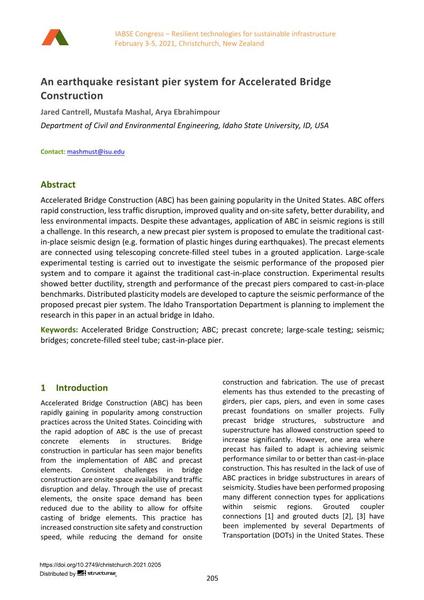An earthquake resistant pier system for Accelerated Bridge Construction

|
|
|||||||||||
Détails bibliographiques
| Auteur(s): |
Jared Cantrell
(Department of Civil and Environmental Engineering, Idaho State University, ID, USA)
Mustafa Mashal (Department of Civil and Environmental Engineering, Idaho State University, ID, USA) Arya Ebrahimpour (Department of Civil and Environmental Engineering, Idaho State University, ID, USA) |
||||
|---|---|---|---|---|---|
| Médium: | papier de conférence | ||||
| Langue(s): | anglais | ||||
| Conférence: | IABSE Congress: Resilient technologies for sustainable infrastructure, Christchurch, New Zealand, 3-5 February 2021 | ||||
| Publié dans: | IABSE Congress Christchurch 2020 | ||||
|
|||||
| Page(s): | 205-211 | ||||
| Nombre total de pages (du PDF): | 7 | ||||
| DOI: | 10.2749/christchurch.2021.0205 | ||||
| Abstrait: |
Accelerated Bridge Construction (ABC) has been gaining popularity in the United States. ABC offers rapid construction, less traffic disruption, improved quality and on-site safety, better durability, and less environmental impacts. Despite these advantages, application of ABC in seismic regions is still a challenge. In this research, a new precast pier system is proposed to emulate the traditional cast- in-place seismic design (e.g. formation of plastic hinges during earthquakes). The precast elements are connected using telescoping concrete-filled steel tubes in a grouted application. Large-scale experimental testing is carried out to investigate the seismic performance of the proposed pier system and to compare it against the traditional cast-in-place construction. Experimental results showed better ductility, strength and performance of the precast piers compared to cast-in-place benchmarks. Distributed plasticity models are developed to capture the seismic performance of the proposed precast pier system. The Idaho Transportation Department is planning to implement the research in this paper in an actual bridge in Idaho. |
||||
| Mots-clé: |
ponts
|
||||
